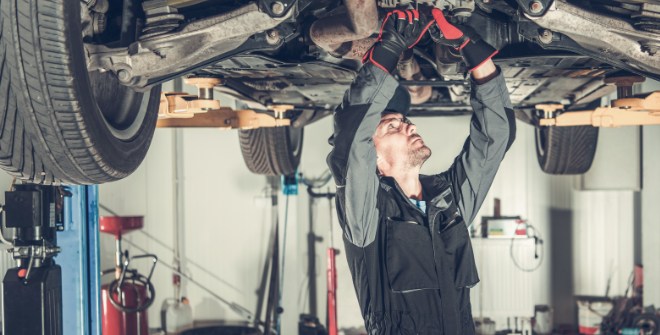Creating a Vehicle Maintenance Budget

Unexpected car repairs and maintenance can strain your budget, lead to stress, and even delay essential auto services, leading to more expensive repairs down the road. In fact, many Americans cannot pay for an unexpected car bill.
Fortunately, a dedicated car maintenance fund can help prevent these financial setbacks, paying for routine care and doubling as a buffer in case of an emergency.
How to Create a Budget for Car Maintenance
While everyone has their own method for budgeting, here is a simple approach from Christian Brothers Automotive to get started with your vehicle maintenance budget:
1. Collect All of Your Car Maintenance Records from the Past Year
What you'll gather depends on how you pay for things, but you'll want to look through your checkbook register, bank statements for your credit and debit card, receipts, and anything else you think would give you an idea of how much car maintenance cost you in the past year.
Maintenance costs include repairs, oil changes, tire rotations and alignments, brake pad replacements, battery checks and replacements, wiper replacements, auto repairs, and other necessary work to keep your car driving.
It's important to note that your car maintenance budget shouldn't include car payments, insurance, registration, or taxes. That should be a part of your personal budget.
2. Categorize Records and Add Maintenance Costs
With your records in hand, categorize your maintenance expenses into categories. This could be based on the type of service, such as "oil changes" or "brake repairs," or it could be organized by date. Whatever method works best for you to get an idea of how much you've spent in each category over the past year.
Then, add up all of your maintenance costs for the entire year and divide by 12 to find your monthly average, or you can divide by the number of months your records cover. This gives you an average monthly cost for each type of maintenance.
For example, Joe spends $600 on oil changes, $300 on brake repairs, and $200 on tire rotations over a year. This totals $1,100 in maintenance costs. Dividing by 12 gives him an average monthly cost of $91.67 for maintenance – that's a great starting point for his budget!
3. Consider Your Future Needs
Your vehicle's age and mileage also influence your budget, so if your car is relatively new, you may not need to budget as much since it generally requires less frequent maintenance compared to an older vehicle with higher mileage.
However, if your vehicle is older or has over 100,000 miles, you may want to budget for more frequent repairs and replacements. Consider your vehicle's age and mileage when creating your budget. Consult your owner's manual for mileage-based maintenance milestones.
And remember, some months may be higher than others and vice versa. Your budget will ebb and flow, but the important thing is that you have a general idea of how much to allocate for car maintenance each month.
4. Find a Place to Save It
Once you have an idea of how much your car maintenance is expected to cost and you start budgeting for it, you need to find a place to put that money. There are several options:
- Create a separate savings account specifically for car maintenance expenses; a high-yield savings account can help you make money while you save money
- Set up an envelope or use a jar at home to hold cash designated for vehicle maintenance
- Add the amount to your general savings or emergency fund – just be sure to keep track of how much is allocated for car maintenance separately
- If you have a budgeting app or software, create a car maintenance category to allocate the funds
5. Be Prepared for the Unexpected
Even with a well-planned vehicle maintenance budget, unexpected car repairs can still occur. That's why it's important to have an emergency fund set aside for such situations. This fund should be separate from your regular car maintenance budget and only used in case of urgent auto repairs.
Having this extra cushion will help you avoid dipping into your other savings or having to rely on credit cards to cover the cost of unexpected car repairs.
Get Help from Your Friends at Christian Brothers Automotive
Creating a vehicle maintenance budget may seem like just another financial task, but it can save you from unnecessary stress and major expenses in the long run.
Need help keeping your car in top shape on a budget? Bring your car to Christian Brothers Automotive for routine maintenance! Our expert technicians will help keep your vehicle in top condition so you can stay on the road worry-free.
Find your local Christian Brothers Automotive today, and let us take care of your vehicle! We make car maintenance easy and affordable so you can focus on enjoying the ride.
Frequently Asked Questions about Vehicle Maintenance Budgeting
Now that you've got a budgeting plan, let's address some common questions about vehicle maintenance budgets.
Q: How Much Should I Budget for Vehicle Maintenance?
A: We recommend setting aside at least $100 per month for car maintenance and adjusting to reflect the actual condition of your car or any upcoming major auto services required (i.e., brake replacements, tire replacements, etc). If you have an older car or one with higher mileage, consider budgeting more.
Q: How Much Does the Average Person Spend on a Car Monthly?
A: When owning a car, remember to consider loan payments, insurance, and maintenance prices. Loan payments range from $300 to $600 per month, while insurance can be $100 to $200 monthly, depending on various factors. With a recommended maintenance budget of at least $100 per month, the total monthly cost of owning a car ranges from $500 to $900 or more.
It’s important for car owners to consider these figures when planning their budgets to ensure they can comfortably afford the total cost of owning and maintaining a vehicle.
Q: What Maintenance Does a Car Need Every Month?
A: Car maintenance tasks are typically performed based on mileage or time intervals, rather than on a strict monthly schedule. Here's a breakdown of the most common scheduled maintenance tasks and their typical intervals:
- Oil Changes: Intervals vary by vehicle, but most fall between 5,000-10,000 miles or every 6-12 months, whichever comes first.
- Tire Rotations: Every 5,000-8,000 miles or every six months helps ensure even tire wear.
- Filters:
- Engine Air Filter: Replaced every 15,000-30,000 miles, depending on driving conditions.
- Cabin Air Filter: Replaced every 15,000-25,000 miles or once a year, depending on driving conditions.
- Oil Filter: Changed with every oil change.
- Belts:
- Timing Belt: Critical replacement at the manufacturer's recommended interval (typically between 60,000 - 105,000 miles).
- Serpentine Belt: Replace at intervals specific to your car (typically between 60,000 - 100,000 miles).
- Brake Pads: Lifespan varies greatly depending on driving habits and conditions. Look for wear indicators, listen for squeaking, and have them checked during tire rotations or oil changes.
Note: Always consult your vehicle's owner's manual for specific maintenance schedules and recommendations, as they may vary by make, model, and year.

[1].jpg)
[2].jpg)
sunwash-tech-with-customer.png)
